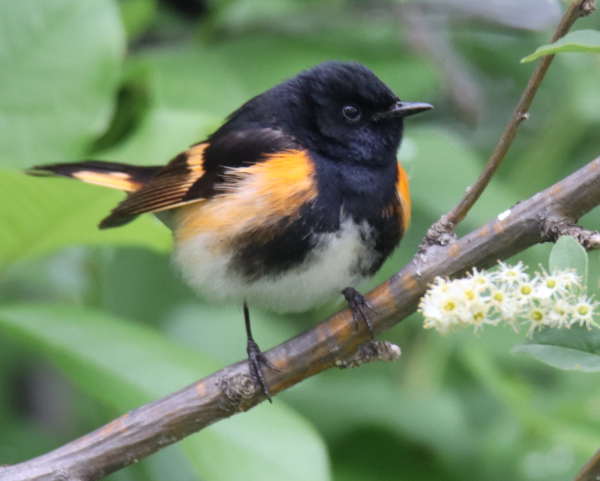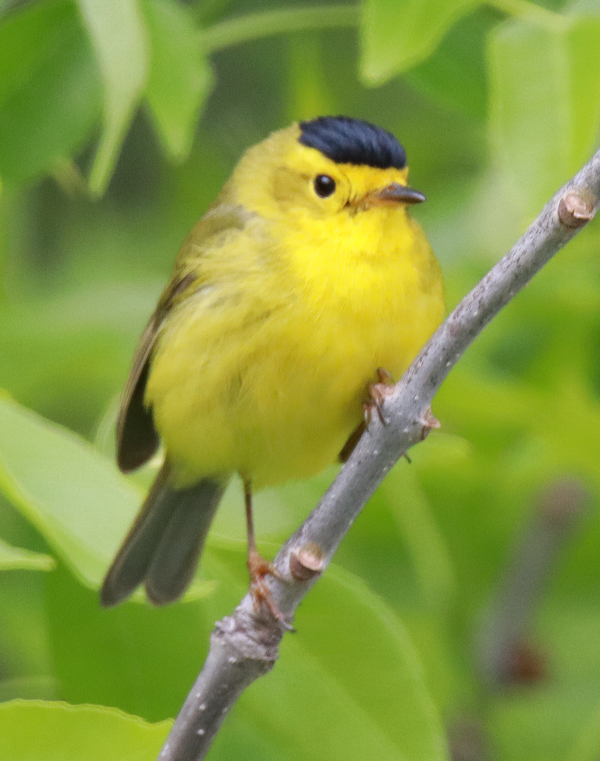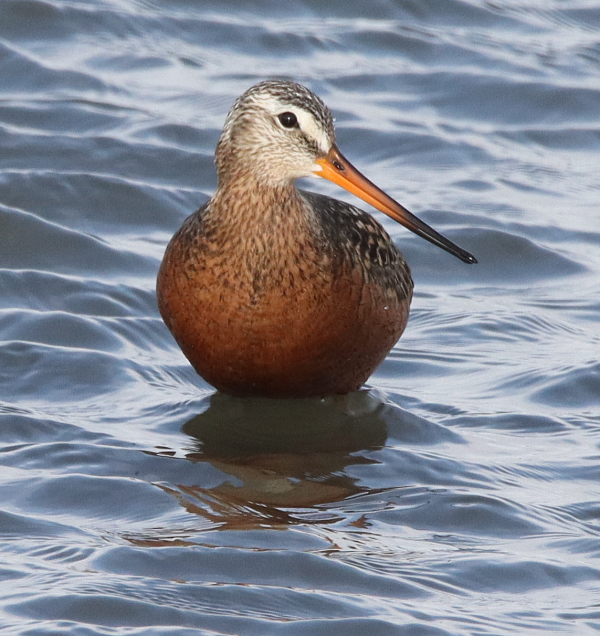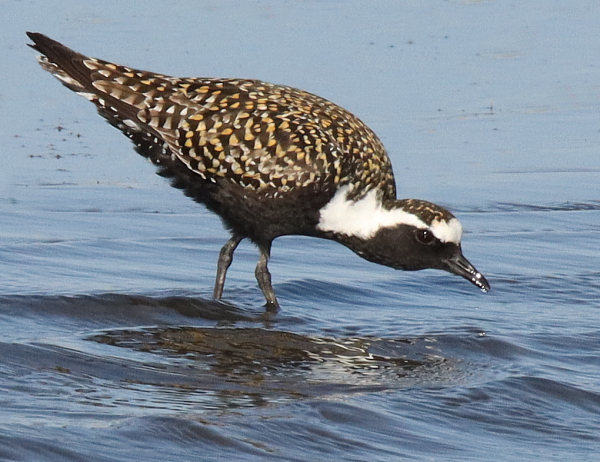
During a warbler fallout Saturday, the number of Chestnut-sided Warblers was especially surprising among the total of 8 species of warblers mixed with other migrating songbirds, flycatchers, and swifts.

American Redstarts were a welcome addition to the warbler foraging at Melody’s Grove Saturday, including several males and females.

The fast action of the many foraging warblers made the mid-May migration stop both enjoyable and exciting, especially when trying to photograph the small species like this Wilson’s Warbler.

Probably a yearling male, this Hudsonian Godwit is only partly molted, but the variety in the different molt sequences made it easier to identify individuals during observation periods.

Fully molted into colorful adult plumage, this male was 1 of 3 that was foraging Thursday evening, including a still molting male and a female.

A lone American Golden Plover suddenly appeared across the bay during “Shorebird Thursday,” then turned and began drinking near in the shallow water. Following by a fast-paced bath, the elegant full-color Golden lifted off again.
|
An epic day that will stand as monumental in my personal birding history unfolded during the most unlikely weather Thursday afternoon less than 2 miles north of my office where a variety of shorebirds concentrated. In the little shallow bay that has been a true shorebird hotspot I was surprised again and again by the appearance of 4 species that I have rarely sighted during spring migration! Would you believe I observed American Golden Plovers, Buff-breasted Sandpipers, Hudsonian Godwits, and Ruddy Turnstones all in the company of a variety of other shorebirds within an hour?!
After a sudden downpour of rain that forced me back into my house, I ventured back into the field to check on 2 local shorebird hotspots. The first one was the drying shallows of a little bay on the south side of Bobby’s Lake. As I pulled off the road, the unexpected sight of 7 Ruddy Turnstones cleared my mind of any other thoughts as I quickly grabbed my camera and began photographing, and there was a Hudsonian Godwit too! They were surrounded by Dunlins, Stilt Sandpipers, Semipalmated Sandpipers, a Pectoral Sandpiper, 2 pairs of American Avocets in addition to a few Blue-winged Teal. I hadn’t seen Hudsonian Godwits for a number of weeks, but I eventually was able to ascertain there were at least 4 different Hudsonians visiting the bay. The next shorebirds to arrive were rarer yet – 2 Buff-breasted Sandpipers!
The Buff-breasted Sandpipers landed at the far end of the bay, as did later groups of 2, 6, and 2. One of the males even displayed, holding it wings cupped in front of it with its beak pointing at the sky – so exciting to witness, but too far away to get good photos to document the action. American Golden Plovers surprised me at this bay 3 days earlier when I drove by nonchalantly, only to realize there were 52 Goldens spread across the far mudbar, some drinking and bathing near the shore. What were the chances of some American Golden Plovers stopping by to make it a Fantastic 4 collection of rare shorebird sightings Thursday afternoon?
You see, to date I have only encountered Ruddy Turnstones twice before during spring migration, Buff-breasted Sandpipers and Hudsonian Godwits only 3 times before, and last week was the first time I’ve ever found American Golden Plovers during spring migration in the northern Great Plains! After seeing 52 Goldens Monday at Bobby’s Bay, there were 3 and 8 there during 2 bay visits Tuesday, and I intercepted 6 there Wednesday; but would any appear during Thursday’s ongoing trifecta of rare migrating shorebird sightings? Yes, after about 1½ hours, a single American Golden Plover was suddenly standing on the opposite shore when I looked up from my camera while photographing Ruddy Turnstones.
The Golden Plover leaned over and drank, showing its gold, black, and white plumage; then stepped forward and bathed in a hurried fashion. It seems the American Golden Plovers and Buff-breasted Sandpipers only come to the bay to drink and bathe, or just to drink – then they leave, flying to nearby upland fields where they rest, or forage. On the other hand, the Hudsonian Godwits and Ruddy Turnstones foraged nonstop any time I saw them, which is true for the other migrants that will continue much farther north.
As noted in the beginning of this article, I wanted to check a second birding location, which is 10 miles farther north. The previous day, Wednesday, I saw a big flock of suspicious-looking birds in the distance at the far end of the rain-flooded field, and when I looked with binoculars, it turned out they were American Golden Plovers! This flock was far too large to count individual birds, so I counted by 10s, and was amazed at the final count – 460 Golden Plovers!! Thursday it was quickly obvious that the big flock was gone, but I found a lone Golden where there were hundred before – ha – nice to see ya.
Stormy Friday Birds
Rain blowing 30mph in a southeast direction, kept me pretty sedentary Friday, but seeing the first Red-headed Woodpecker of the year is always a cause of personal excitement, as is the first female Baltimore Oriole, a grape jelly feeder visitor. The oriole seemed to open the door to a variety of birds that foraged among the new leaves growing on the elm tree outside my bay windows, beginning with a nice male Blackpoll Warbler, a Yellow Warbler, Clay-colored Sparrow, Warbling Vireo, and a Black-and-white Warbler in that order; along with a couple more ground-oriented Swainson’s Thrushes and a Brown Thrasher.
Those sightings were obviously evidence of a little songbird fallout, although when I checked Melody’s Grove, there was only a Yellow Warbler, an Eastern Kingbird, and a small flock of Barn Swallows foraging on the wing above an adjacent area of tall grass. It’s noteworthy to point out that since the male Baltimore Orioles arrived at my feeding station the previous Sunday, I haven’t seen an oriole since, until Friday’s female. Of course I checked on the shorebirds at Bobby’s Bay a couple times, but the only rare bird was a lone Hudsonian Godwit.
The Second Warbler Fallout!
Saturday morning after the rainy days, I checked on shorebirds at the bay and almost went home because BirdCast showed no overnight migration in my county, but I couldn’t resist checking on Melody’s Grove for any songbird that might have repositioned. Luckily I did, because the Grove was very active and became more active with each hour I spent there! As if the shorebird parade wasn’t exciting enough 2 days earlier, the warbler fallout was one for the books too!
Most surprising were Chestnut-sided Warblers, that started with a single bird, but built to a point in mid-afternoon that this rare species almost always in sight as they foraged in the low trees where I positioned my mobile blind for an extended warbler photo session. I have only seen 1 previous Chestnut-sided Warbler in the region, some years ago, so to see 1 more was exciting, and to see a parade of them was unimaginable, until now. The rarer warblers that May 17th were a single Mourning Warbler and 2 Black-and-white Warblers, and there were no Yellow-rumped Warblers. Add to that a few Common Yellowthroats, several Wilson’s Warblers, plenty of Yellow Warblers including many females and yearlings, many Tennessee Warblers; and I hesitate to say there were many American Redstarts, but there certainly were a lot of males and females!
Beyond the abundance of warblers, there were Swainson’s Thrushes, Gray Catbirds, Brown Thrashers, American Robins, House Wrens, many Least Flycatchers, and a flock of Chimney Swifts that foraged above the tall grass area like the Barn Swallows did the day before. There was 1, maybe 2 Red-headed Woodpeckers, but no orioles, until I returned home where the female Baltimore Oriole continued to stop by my feeding station for grape jelly. I’ve been waiting for the next wave of warblers to arrive, and the birds were so abundant, so active, and so attractive that I couldn’t break away from the usually fast-paced warbler photography and songbird observations. That said, I didn’t get a chance to visit the Old Schoolhouse Grove, although the road was probably very muddy anyway.
As I write this, I’m about to board a jet to Europe, a change of continents for a few days of birding in the Eastern Hemisphere, in northeast Portugal on the shore of the Atlantic and inland. It was a surprise trip that materialized quickly – I’ll tell you all about the birds I observed next week! In the meantime, enjoy the new birds you find, and the old birds too – and enjoy all your birding opportunities!
Article and Photos by Paul Konrad
Share your bird sightings and photographs at editorstbw2@gmail.com